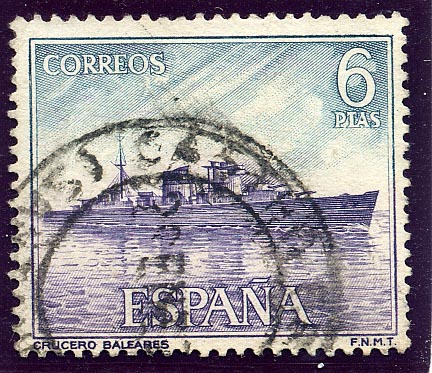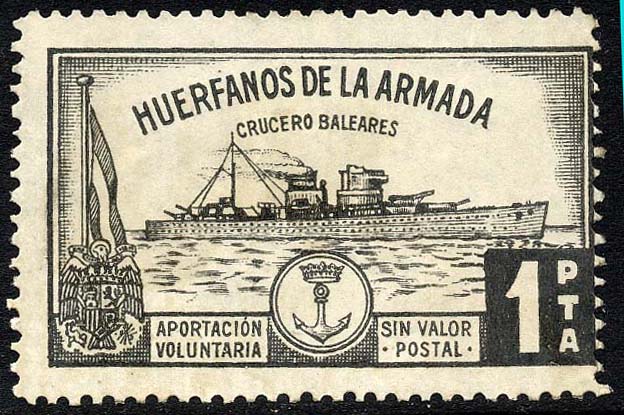

Laid down: 15 August 1928. Launched: 20 April 1932. Completed: 28 December 1936. Sunk: 6 March 1938
Like her sister, Canarias, at the beginning of the Spanish Civil War the Baleares was laid up at El Ferrol . She entered in service, still unfinished, in December 1936.
The Baleares did not carry the fourth turret until the summer of 1937. She accompanied the Canarias in the first missions at the beginning of 1937, but she operated almost always alone thereafter. At dawn on May 20, while escorting a tanker in fog, she crossed the bulk of the Republican fleet, (two cruisers and six destroyers) but was only able to spot the first two ships in the line and exchanged fire with them without consequences on either side.
On 12 July, off Valencia the cruiser found six Republican destroyers escorting two ships. She scare them off with gunfire but the freighters could escape.
In the morning of 7 September, alone again, the Baleares found a convoy of four westbound freighters, escorted by the Libertad, the Méndez Núnez and seven destroyers off cape Cherchell (Algeria). Though in an unfavorable position, between land and the enemy force, the Nationalist cruiser engaged the two opposing cruisers while Republican destroyers would stay with the convoy. Despite fire from the Baleares was far from accurate, she managed to score a hit on the Libertad, but received was in turn two shells from the enemy cruiser and one of them started a dangerous fire in the 120 mm magazine. While the other cruiser Méndez Núnez was out of Baleares' range, the Libertad broke off the engagement and turned toward the convoy. The Baleares then started to shadow the enemy fleet. In the afternoon, after repeatedly losing contact, the Baleares was able to find the Republican cruisers again and another inconclusive skirmish started. She eventually broke off the contact and waited for the Canarias, steaming from Ceuta, to resume the chase. But the two Nationalist cruisers could no longer find the convoy that meanwhile had entered the port of Cherchell. Neither were they able to spot the enemy warships, enroute to Cartagena. Despite the damage the lonely Baleares could prevent the enemy convoy from reaching their destination in the Spanish Republic.
In the following months she continued to team with the Canarias in nearly all her missions.
The night between 5 and 6 March 1938, the three Nationalist cruisers were escorting two freighters, seemingly a routine operation (Admiral Moreno the squadron commander, had just given the fleet to his subordinate admiral Vierna) met with a degree of overconfidence. The Republican admiral Ubieta had prepared a raid of MTBs against the cruisers in Palma de Mallorca with the distant support of the Republican fleet. The MTBs operation was cancelled due to the bad weather, but Ubieta decided to stay at sea. Thus the two forces were on a collision course, without either knowing one of the other, toward Cape Palos . At 00.36, almost at the same time, the cruisers Libertad and Méndez Núñez and the five accompanying destroyers sighted the three Nationalist cruisers at 2,000 meters, but only one of the destroyers could manage to fire torpedoes before losing contact. The two forces made several course changes and at 02.00 the Baleares found the enemy squadron again and opened at some 2000 meters. But this time admiral Vierna made the mistake of firing star shells on the horizon, giving away his position to the enemy. Now the Republicans had time to respond: the Baleares was hit by gunfire from the Libertad and almost simultaneously by one or two torpedoes (probably from the Lepanto) that wrecked the ship and blew up the forward magazine and the bridge. The ship stopped dead on fire from bow to stern, quickly developing a list. The Canarias, right behind the Baleares, dodged the hulk, and guided the Cervera outside enemy range. The Republicans didn't pursue and left the area. Canarias and Cervera escorted the convoy until safely homed, then returned to rescue the survivors. Royal Navy destroyers joined in the operation but 700 men had already followed the cruiser to the bottom of the sea.
SG1672 and label?
SB Dec 1964 and Wikepedia
